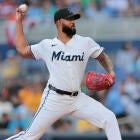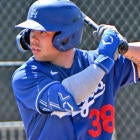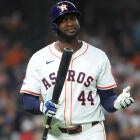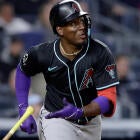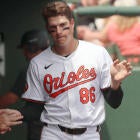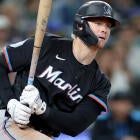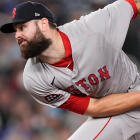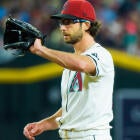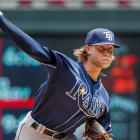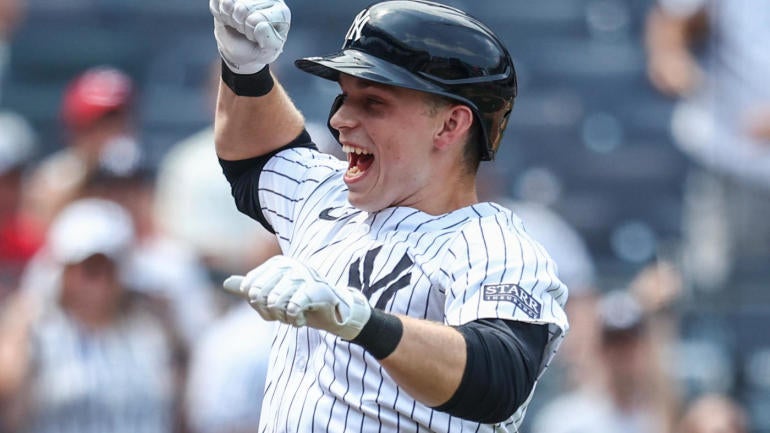
When the Yankees called up Ben Rice to fill in for an injured Anthony Rizzo (fractured forearm) at first base, I'll admit I didn't give him the time of day.
In past years, I might have, if only because his minor-league production was considerable. He hit .324 with 20 homers and a 1.048 OPS in just 73 games last year and had slashed .275/.393/.532 prior to getting the call this year. But in spite of those numbers, Rice wasn't a highly-regarded prospect, and in a year when ones as highly regarded as Wyatt Langford, Jackson Chourio and Jackson Holliday have all struggled to find their footing ... well, you kind of stop believing in miracles.
How's this for a miracle?
Here's Ben Rice hitting 1,202 feet of home runs against the Boston Red Sox: pic.twitter.com/AKDjMhZFqw
— Fireside Yankees (@FiresideYankees) July 6, 2024
What the video reveals is all three of the home runs that Rice hit in a single game Saturday, and as you'll notice, none was a creation Yankee Stadium, with its short porch in right field. Their exit velocities were 103.7 mph, 105.1 mph and 110.8 mph, with the hardest-hit setting a new personal high by more than 3 mph, and all three would have been home runs in at least 29 of 30 ballparks. There was nothing artificial about them, in other words.
What was artificial was the prospect ranking that caused me to dismiss Rice in the first place.
I suspect that Rice's tepid prospect ranking had to do with his defensive shortcomings as a catcher, leaving first base as his most viable path to the big leagues. It's a path that crowds out many talented hitters, seeing as first base is the ultimate fallback position, and those who get the opportunity have to seize it right away. Rice appears to be doing that. It's not just the three-homer game. It's the low ground-ball rate (30.2 percent). It's the high pull rate (48.8 percent). It's the swing that's optimized for both batting average and home runs and the plate discipline that assures he'll have something to swing at. He entered Sunday with a .338 xBA and .698 xSLG, which are of course too good to be true, but when a player with his minor-league track record checks this many boxes right away, it's something to take seriously. And because Rice retains catcher eligibility, he doesn't need to play quite every day to have an impact.
| ||||||||||||
Let's count Thursday as part of this weekend, seeing as it was a holiday. While most were setting off fireworks, Jose Miranda was putting on a laser show, going 5 for 5 with three doubles, but you could argue it wasn't even his best performance of the weekend. The very next day, he went 4 for 4 with a homer and a double. In all, he went 12 for 13 across four games, raising his batting average from .297 to .331. It probably won't stay at .331, but it certainly makes the .297 more believable when he can go on a four-day run like that. His 89th percentile xBA is yet another indication that Miranda's fine hitting isn't just a mirage. He may have let us down last year and still has only middling exit velocities, but it's time to buy in hard on a player who has made himself an integral part of the Twins lineup.
| ||||||||||||
Brooks Lee's first five games in the majors couldn't have gone much better than they did. He collected nine hits in 19 at-bats, striking out just twice, and even connected for his first home run Saturday. He hit the ball just 99.8 mph, which isn't normally the sort of exit velocity you see on a home run, and yet it traveled 395 feet, making it no cheapie. These seemingly incongruous details fit with what we saw from him at Triple-A, where his 85.4 mph average exit velocity and 104.9 mph max exit velocity seemingly shouldn't have added up to seven homers (to go along with a .329 batting average) in 85 at-bats, but maybe he's one of those rare hitters who angles the ball so perfectly off the bat that the exit velocities become a secondary factor. If nothing else, the hit tool appears to be as advertised, making Lee worth adding anywhere he's still available.
| ||||||||||||
Kevin Gausman followed up his worst start of this largely forgettable season with one of his best, but it isn't just the results that earn him a nod here. According to the team's official website, Gausman changed his mechanics for the start, becoming more "hunched over" on the mound. "It's something [where] we're trying to get back to what I was doing in 2021," he said. "I think it will allow me to be around the zone a little bit more." Indeed, he threw 69 percent of his pitches for strikes Friday, but of even greater note were the 21 swinging strikes, 17 of which came on his four-seamer, which came in at a lower angle and higher velocity (by 1.4 mph). While the mechanical change didn't improve the drop on his splitter, which has been his biggest issue this year, it's a substantive change that clearly had an immediate impact, renewing hope that Gausman will be able to salvage his season.
| ||||||||||||
Andrew Heaney's best season in a career of mediocre seasons was 2022 when he had a 3.10 ERA, 1.09 WHIP, and 13.6 K/9 for the short time he was healthy. What he also had was a slider that averaged 83.4 mph, the best mark of his career. So it's notable that his slider velocity has been higher in three of his past four starts, including Saturday's, and it's also notable that he has a 2.45 ERA, 0.87 WHIP, and 12.8 K/9 in those three starts. Has he figured something out? We should at least be open to the possibility given that we've seen this version of him before. If you're short on pitching, Heaney is now worth a speculative pickup.
| ||||||||||||
Through seven career games, James Wood's biggest flaw is apparent. He's put the ball on the ground 77.8 percent of the time, which is considerably worse than his already alarming rate of 52.4 percent at Triple-A. And yet through seven career games, it sure seems to be his only flaw. He's hit the ball 96.9 mph on average, which is better than even Aaron Judge, so he's making the fly balls he does hit count, as was the case on his first career home run Saturday. He has also carried over his superlative plate discipline from the minors, walking nearly as often as he's struck out, which is especially impressive given his 6-foot-7 frame. In a year when so many elite prospects have failed to deliver immediate results, Wood already looks to be an exception, and my hunch is that his ground-ball rate will drop faster than his other numbers do.
| ||||||||||||
You'd think Spencer Schwellenbach was a grizzled veteran with his superlative strike-throwing and deep arsenal of pitches (six in all) that he seems to arrange differently every time out. But he's actually in just his second professional season after a college career spent mostly as an infielder. It gives you some idea how quick of a learner he is, which is all the more reason to believe he turned the corner with his latest start Saturday. This time, he arranged his arsenal such that he threw his best swing-and-miss pitch, the splitter, twice as often as usual (20 percent), and yet he still landed 74 percent of his pitches for strikes. His overall strike rate of 71 percent would rank tops among qualifiers, so if he can find the right pitch mix, there may be no stopping him.
| ||||||||||||
Saturday's start was the second bad one in a row for Ranger Suarez, raising his ERA from 1.83 to 2.58. And that's how quickly a pitcher can go from looking like mid-'90s Greg Maddux to ... something more conventionally good. His success was built on the perfect placement of his changeup down in the zone, and mere mortals can't sustain perfection forever. He's thrown just 62 percent of his pitches for strikes in his last two starts compared to 66 percent in his first 16. He's still an elite ground-ball pitcher backed by one of the best offenses in baseball, but this may be just the start of a regression that ends with his ERA in the low threes.
| ||||||||||||
Has the magic run out for the Rays? After moving on from Aaron Civale, they're still left with the husk of Zach Eflin, their miracle free-agent find from just a year ago. Back then, he had a 3.50 ERA, 1.02 WHIP and 9.4 K/9. His 4.19 ERA, 1.15 WHIP, and 7.0 K/9 this year are a far cry. What's most evident is that the strikeouts have dried up. His curveball was mostly responsible for them, and it's more the usage of the pitch than the characteristics that have changed. Even so, we're talking about 7 percentage points difference, which is hardly night and day. The ERA estimators still generally like Eflin, in large part because of his immaculate control, but in a season that's been so favorable to pitchers, Eflin's continued underachievement is damning. I wouldn't say I'm totally committed to rostering him in shallower leagues anymore.
| ||||||||||||
The remaking of Luis Severino from a premier bat-misser to a ground-ball specialist seemed to be going a little too smoothly, and sure enough, it's hit the skids in his past four turns. One of those starts was good, actually, but even including it, he has a 6.04 ERA during that stretch. He also has just 17 strikeouts in 25 1/3 innings, and 10 of them came in the good start. Clearly, he hasn't gone back to his bat-missing ways, and yet the ground balls have dried up as well. It's why he's fallen victim to six home runs during that four-start stretch. If dominance is no longer Severino's game, then he'll need to make up for it with consistency, and he clearly isn't doing that at this stage. It's a wonder that he ever did.
| ||||||||||||
![[object Object] Logo](https://sportshub.cbsistatic.com/i/2020/04/22/e9ceb731-8b3f-4c60-98fe-090ab66a2997/screen-shot-2020-04-22-at-11-04-56-am.png)



























